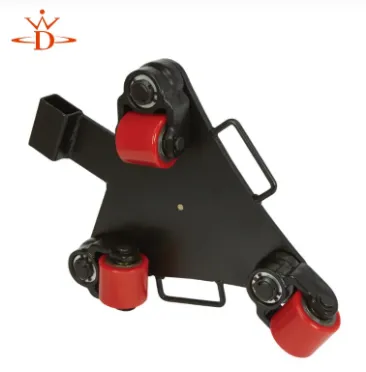Power Meets Precision: Choosing the Right Machinery Mover for Heavy Load Handling
Moving heavy industrial equipment safely is a challenge that only the right tools can overcome. From production line shifts to plant-wide equipment relocations, having a dependable machinery mover is crucial. These transport systems are engineered to handle extreme weights with control, stability, and safety. But not all movers are built the same. Whether you're navigating narrow aisles or lifting complex equipment, choosing between hydraulic and electric systems can make all the difference.

Hydraulic vs. Electric Machinery Mover: Pros and Cons
When it comes to choosing a machinery mover, the two most common types are hydraulic and electric. Each comes with its own set of benefits and limitations based on your project’s requirements.
A hydraulic machinery mover relies on fluid pressure to lift and carry equipment. The biggest advantage is its raw lifting power and cost-efficiency. It requires minimal electrical input, making it a strong choice for rugged sites with limited power access. However, hydraulic systems can be slower and more prone to leaks over time, requiring periodic maintenance.
In contrast, an electric machinery mover offers smoother operation, higher precision, and faster relocation. It's ideal for controlled environments like factories and laboratories. Integrated motors and remote navigation allow for effortless movement of heavy equipment skates, with less physical effort and more safety. The downside is its higher initial investment and dependence on battery charging or direct electrical input.
Both systems can be paired with heavy duty machine dolly and cargo trolley accessories for specific tasks. Understanding your workspace, mobility needs, and environmental factors will help determine which mover is best suited for the job.
Choosing the Right Machinery Mover Based on Load Weight
Every project begins with one question: How heavy is the equipment you're moving? Selecting the proper machinery mover depends heavily on weight classification. Underestimating your load can lead to system failure, while overestimating may cost you more than necessary.
For lighter machinery up to 5 tons, compact heavy equipment skates or manual cargo trolley units may suffice. They offer flexibility and easy handling with minimal setup. For medium loads ranging from 5 to 30 tons, a heavy duty machine dolly combined with a hydraulic machinery mover gives you the balance of affordability and safety.
For loads beyond 30 tons, it’s best to use a multi-unit electric machinery mover system that distributes weight across multiple touchpoints. These units offer remote operation, advanced load balancing, and integration with automated lift systems. Our catalog includes various cargo trolley for sale models specifically rated for high-capacity industrial transport.
When in doubt, consult with our load-matching specialists. We’ll evaluate your machine dimensions, floor material, and desired path to recommend the perfect machinery mover configuration.
Understanding Safe Bearing Standards for Machinery Movers
No matter how tough a machinery mover looks, it’s only as good as its certified bearing capacity. Industry-standard bearing loads are based on stress tests, usually over 150% of the unit’s rated capacity, to ensure safety margins under real-world conditions.
All of our heavy duty machine dolly, cargo trolley, and heavy equipment skates are tested under dynamic and static loads. Static load capacity refers to a load at rest, while dynamic load capacity applies during movement. A 10-ton rated machinery mover must handle at least 15 tons in a test environment without any structural distortion.
Additionally, safety factors such as weight distribution, floor slope, and shock absorption are calculated during design. Our bearing standards exceed ANSI and ISO benchmarks, and we provide full technical sheets for every cargo trolley for sale, ensuring buyers understand exactly what their system can handle.
Complete Handling Systems: More Than Just a Cargo Trolley for Sale
While it's tempting to browse online for the lowest cargo trolley for sale, the true value lies in selecting the right system for your needs. We offer more than just competitive pricing—we provide tailored solutions that integrate machinery mover, heavy duty machine dolly, and heavy equipment skates into a full handling workflow.
From consultation and design to delivery and post-purchase support, our focus is on performance and longevity. Our cargo trolley models come with non-marking wheels, pivoting tops, and reinforced frames. These features protect your floors and your machines during even the most challenging relocations.
Whether you're moving presses, injection molding machines, or turbines, our all-in-one systems ensure safety, efficiency, and unmatched load control. And with in-stock availability and expert advice, you’re never left guessing.
Machinery Mover FAQs
What are the advantages of hydraulic vs. electric machinery mover systems?
Hydraulic systems offer powerful lifting and lower cost, while electric systems provide speed, precision, and remote control features. The right choice depends on your environment and equipment needs.
How do I select the right heavy duty machine dolly for my machinery?
Consider the total weight, dimensions, and load distribution. A heavy duty machine dolly should be rated at least 25% higher than your expected load for safety.
What is the safe bearing standard for a cargo trolley?
It depends on the manufacturer, but a certified cargo trolley should handle at least 150% of its rated capacity during stress tests. Always check dynamic and static load ratings before purchase.
Are heavy equipment skates suitable for long-distance movement?
Yes, high-quality heavy equipment skates with steel rollers and reinforced frames are designed for both short and long-distance equipment moves across flat surfaces.
Where can I find a reliable cargo trolley for sale with expert support?
We offer a variety of cargo trolley for sale units with free load assessment, technical documentation, and real-time customer service to ensure you select the right product for your application.
-
Dawei Hand Pallet Truck 1200mm, 2000–5000 KGS Heavy-DutyニュースNov.17,2025
-
Dawei Hand Pallet Truck, Fork Length 1200mm, 2000–5000kgニュースNov.17,2025
-
Large Equipment Movers – Safe, Insured & On-Time ServiceニュースNov.17,2025
-
Machine Moving Dollies | Heavy-Duty, Low-Profile, SafeニュースNov.17,2025
-
Permanent Lifting Magnet - Heavy-Duty, Safe, Quick ReleaseニュースNov.11,2025
-
PML 1000 Lifting Magnet - Heavy-Duty, Safe, No PowerニュースNov.11,2025
-
Large Equipment Movers: Safe, Fast, Certified ProsニュースNov.11,2025
